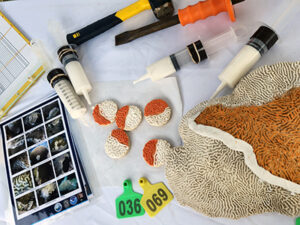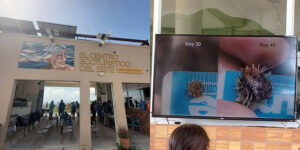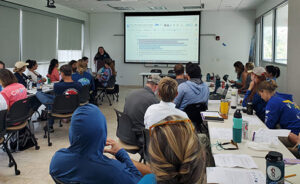
During the workshop, colleagues shared a recent example of how to engage the public with coral disease impacts. A local bakery created SCTLD cookies that kids could decorate and take home with them. Credit: Ceiba Strategies, Inc.
Lexie Sturm is a 2023 Knauss Fellow, currently working at the NOAA Coral Reef Conservation Program.
Takeaway: Coral reef researchers and managers from the U.S. Virgin Islands, Puerto Rico, and Florida met together in San Juan, Puerto Rico for the 2023 U.S. Regional Caribbean Stony Coral Tissue Loss Disease (SCTLD) Workshop. The workshop aimed to share information and experiences across the jurisdictions, improve coordination of U.S. Caribbean coral disease response efforts, and enhance collaboration on coral rescue and communications.
Like many other coral reef researchers throughout the Caribbean, I spent much of the last decade studying Stony Coral Tissue Loss Disease (SCTLD for short). A coral epidemic that rapidly spread across Florida, and later, to the wider Caribbean, SCTLD affects over 25 coral species and has become the deadliest coral disease ever documented. In graduate school, I tracked SCTLD’s spread across Florida’s reefs, investigating environmental factors that may be worsening the disease’s impacts, sampling infected corals in the hopes of identifying the cause, and outplanting coral fragments to begin to help restore what was lost. For the past few years, NOAA’s Coral Program has been supporting an annual workshop to increase collaboration between the USVI and Puerto Rico, whose reefs have been hard-hit by the disease. While last year a virtual workshop was held, this year’s workshop was held in person in San Juan, Puerto Rico. As a Florida Sea Grant Knauss Science Policy Fellow working for NOAA’s Coral Reef Conservation Program, I was thrilled to have the opportunity to support some of the best and brightest minds from across the U.S. Caribbean as they joined together to develop a regional disease response network.
Day 1: A bittersweet reunion
Excitement permeated the air as the workshop participants entered the meeting venue at Centro para Puerto Rico, a local non-profit organization hosting the event. After being unable to convene in person for a region-wide meeting due to our own human pandemic, the energy was palpable and the chatter was loud. After the welcomes, we dove right into SCTLD response updates from the USVI and Puerto Rico. The number of corals lost to the disease was disheartening, but I was also moved by the tens of thousands of corals that had been treated and rescued across the islands. Presentations also highlighted ongoing coral restoration efforts in Florida, Puerto Rico, and the USVI, with a unanimous call to scale up these initiatives.
Funding constraints emerged as a common challenge—resources are needed to build nursery infrastructure and to support large, skilled teams to manage the nurseries and conduct outplanting. By USVI’s estimate, almost 300,000 corals are needed just to restore the ecological function of six reef sites.
We ended the day on a brighter note, learning about the remarkably coordinated SCTLD communications campaigns across the U.S. Caribbean. I was particularly impressed by some of the innovative communications approaches underway. For example, in the USVI, they hired a baker to make cookies that looked like brain corals, and kids used icing to “treat” the SCTLD lesions. In Puerto Rico, they partnered with the local beer company, Medalla, to conduct coral restoration projects—talk about educational, effective, AND delicious!
Day 2: Into the field!
The second day began with an early morning departure for a field trip to the Institute for Socio-Ecological Research (ISER)-Center for Research and Restoration of Marine Organisms in Ceiba, Puerto Rico. Our first stop was the Isabel Rosado Morales Ecotourism Center of the East, a former Navy building that was reclaimed by the local community. Greeted with coffee, snacks, and a breathtaking view of Puerto Rico’s eastern coast, we settled in for a presentation by Dr. Stacey Williams, a researcher at ISER.

The Isabel Rosado Morales Ecotourism Center of the East, a former Navy building, has been reclaimed and is being used by the local community (left). Dr. Stacy Williams gave a presentation on the restoration work that the Institute for Socio-Ecological Research (ISER)-Center for Research and Restoration of Marine Organisms is doing (right).
Dr. Williams shared the organization’s efforts to develop the first land-based coral and sea urchin nursery/hatchery in Puerto Rico. Her presentation was one where the pictures spoke for themselves, as she showed us photos of local reefs before and after herbivorous sea urchin species were restocked and coral fragments were outplanted. Reefs once covered with fleshy macroalgae now had clear open reef space perfect for coral growth and settlement after the algae-munching critters had been released.
After the presentation, we were off to visit the sea urchin nursery! I never knew that small, spiny invertebrates could be so cute! I was amazed by the ingenuity of the ISER team that built the nursery using locally available and out-of-the-box materials (like cattle troughs for sea urchin tanks). They also made the nursery completely modular so that it could be moved in case of a hurricane.
After our visit to the nursery, we headed back to Centro Para Puerto Rico to finish the rest of the day’s agenda. The afternoon’s discussions focused on techniques to save corals from the impacts of the disease and preserve future coral diversity. Drawing from my background in coral genetics, I had a lot of feedback on this topic! We also strategized on funding mechanisms and the need to hire a regional coordinator to turn these ideas into reality.
Day 3: Finding solutions

Participants at the workshop discussing the main objectives.
During discussions, participants identified water quality’s impact on disease progression as a key research priority and emphasized the need for water quality data to locate suitable sites for coral restoration. The team then generated ideas for a joint grant proposal, including hiring a Regional Rescue Coordinator, investigating the resistance of certain coral colonies to SCTLD, and, a particularly creative suggestion, to organize a coral “Spawn-a-thon,” interbreeding corals from Puerto Rico and the USVI to enhance genetic diversity. The best part about having people from diverse organizations is that everybody shared funding ideas that could make these research dreams a reality.
By coming together, participants of the workshop demonstrated a shared vision and commitment to protecting coral reefs in the U.S. Caribbean region. The exchange of knowledge, fostering of collaborative projects, and formulation of innovative solutions hold promise for the future of these fragile ecosystems. A special thank you to the whole planning team for all of your efforts and NOAA’s Coral Program, Florida Sea Grant, Puerto Rico Department of Natural and Environmental Resources, and USVI Department of Planning and Natural Resources for your support!